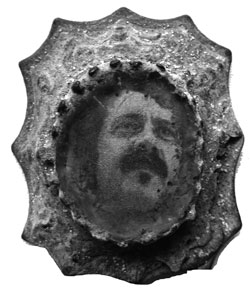|
From The Trenches Issue: 37-1 |
|
You are not right in the head. We like that in a person.
As an example, at the recent Civil War show in Franklin, Tennessee, longtime collector and dealer Fred Schneider approached the publisher and told him of an exciting find he�d made while metal detecting. He then presented with a flourish the excavated portrait pin shown at center here.
The publisher, in turn, gave me the same straight-faced song and dance about its discovery when he showed it to me. It took me a second or two to do the doubletake and announce, not for the first time, "You people are loons."
Not that I can exclude myself from your number. Some years ago I engaged in a frequent gift exchange with readers Randy and Karen Smyth, a gotcha-last series of dummied-up artifacts involving the memorabilia of an apocryphal Civil War soldier who served with the 1st Alaska Pygmy Volunteer Air Corps, CSA. The pygmy designation allowed us to create each item on a small scale, and ... never mind. Eventually the Smyths so soundly trounced me in the cleverness department that I had to cry uncle. For an example of their handiwork, see the handsomely crafted Christmas ornament at bottom right. It hangs on the tree here every Christmas as homage to just how out there our creative readers can get.
Humorously phonied-up artifacts have a long tradition among Civil War collectors, dating back to at least the mid-20th century. Back when original swords were far, far�did I mention far?�less expensive, one well-known (and now deceased) collector delighted in elegantly inscribing blades with the names of his collecting club cohorts� ancestors. He went to these lengths just to see the looks on their faces when they saw what he had "come across." (Although he freely fessed up to the targets of his hijinks, one wonders if any of those inscribed pieces are out in the marketplace now, cut adrift from the elaborate joke that originated their inscriptions.)
In fact, a penchant for practical jokes seems to course through the blood of collectors almost as strongly as the desire to accumulate�although these days economics and an affection for authenticity preclude altering an expensive artifact to accomplish a prank. The fact is that cheap laughs can be had cheaply. For instance, the publisher once brought to a Civil War show a two-piece remote control device that would appeal to any sixth-grader�s sense of humor. The device enabled the holder of the control half to cause the other half, hidden at some distance, to emit a sound like, er, a bleating sheep. Only not.
Imagine that the sheep had consumed five cans of Beanie Weenie.
Lowbrow? Uh huh. Juvenile? You betcha. Funny? That too. The politely accusatory looks among the people in the vicinity of the aural emissions�both sellers and shoppers�were the stuff of which timeless and deliciously immature snickering is made. (I�m reminded of the crawl line I once saw on a news channel when the results of an interplanetary study was released. It read: "Scientists discover Saturn emits gases. Other planets pretend not to notice." The wit who keyed that in probably got canned when a raise would have been in order.)
Over the years I�ve seen collectors set up gags involving everything from PhotoShop to planted artifacts. A warning about that last: The laws of probability do not apply, as the target of the gag will almost never find the piece unless you drag him or her to it and point.
Some might argue that such tomfoolery has no place when it comes to the Civil War, which is a deadly serious topic. I argue that the soldiers themselves were given to high spirits and shenanigans. Most of their stunts --- those that are not lost to time --- are too elaborate to relate here, for elaborateness can be the mark of a truly fine practical joke. Suffice it to say that pulling pranks was a popular pastime. One practical joke involving hiding a Rebel sutler�s mule was so storied that it gave rise to a song ("Mister, Here's Your Mule").
So in my view, some good-natured horsing around does not do a disservice to the soldiers of that war. Rather, it carries on their tradition of life-affirming laughter in the face of all the calamities that life can hand out.
|
| Past From The Trenches click an issue number to view |
| 43-5 |
| 43-4 |
| 43-3 |
| 43-2 |
| 42-3 |
| 42-3 |
| 42-3 |
| 42-3 |
| 42-3 |
| 41-6 |
| 41-5 |
| 41-1 |
| 40-5 |
| 40-4 |
| 40-3 |
| 40-1 |
| 39-6 |
| 39-5 |
| 39-4 |
| 39-3 |
| 39-2 |
| 39-1 |
| 38-3 |
| 38-2 |
| 38-1 |
| 37-6 |
| 37-5 |
| 37-4 |
| 37-3 |
| 37-2 |
| 36-9 |
| 36-6 |
| 36-5 |
| 36-4 |
| 36-3 |
| 36-2 |
| 36-1 |
| 35-6 |
| 35-5 |
| 35-4 |
| 35-3 |
| 35-2 |
| 35-1 |



